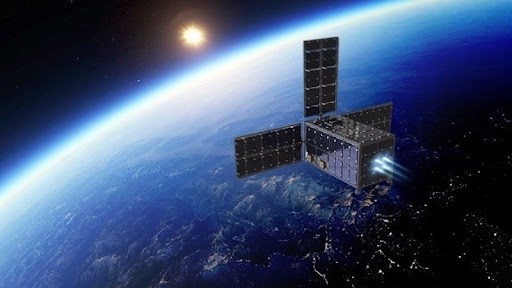Nano F-1 satellite
 |
|
|
This is the first microsatellite research and manufactured by a private Vietnamese corporation. The satellite was launched to the International Space Station (ISS) on July 21, 2012.
Nano F-1 (10x10x10cm, 1kg) is a product of FSpace of FPT University Institute of Technology. It has a low-resolution camera (640x480) to take pictures of the earth; a 3-axis magnetic field sensor to serve the satellite posture determination system and several temperature sensors to collect data from the space environment.
The main purpose of the research and development of the F-1 nanosatellite is to build a team of Vietnamese people capable of mastering space technology through the design and manufacture of satellites and ground stations to control satellites.
The successful launch of the F-1 nanosatellite is an important event marking the ability to manufacture satellites of young researchers of a Vietnamese university, paving the way for future space conquest projects by Vietnamese people. However, it is a pity that the F-1 nanosatellite lost signal it’s when it was released from the International Space Station (ISS).
PicoDragon satellite
 |
|
|
This satellite was launched to the ISS on August 4, 2013. After more than three months kept at ISS, on November 19, 2013, PicoDragon was launched into orbit. This is Vietnam's first microsatellite successfully operating in space.
Pico Dragon satellite has a size 10 x 10 x 11.35 cm, weighing 1 kg. It was developed by young engineers and researchers at the Vietnam Space Center under the Vietnam Academy of Science and Technology. The whole research, manufacturing and testing process of PicoDragon satellite was conducted in Vietnam.
Particularly, the vibration and heat tests were carried out at the laboratory of Professor S.Nakasuka at the University of Tokyo and some other tests were performed at the Japan Aerospace Exploration Agency (JAXA) and the IHI Aerospace Company (Japan).
The mission of PicoDragon is to take pictures of the earth, measure a number of satellite parameters and the space environment by sensors mounted on the satellite and test communications with the ground.
MicroDragon satellite
 |
|
|
MicroDragon was launched into space on January 18, 2019. This satellite was developed by a group of 36 students who are staff of the Vietnam Space Center of the Vietnam Academy of Science and Technology under the guidance and technical support of experts from JAXA and professors of Kyushu Institute of Engineering and Technology, KyuTech (Japan).
These Vietnamese students studied at leading universities in Japan including: University of Tokyo, Keio University, Hokkaido University, Tohoku University and Kyushu Institute of Technology from 2013 to 2017.
MicroDragon is a product in the Basic Satellite Training Component, part of the Project "Prevention of Natural Disasters and Climate Change Using Earth Observation Satellites".
This is a satellite with the task of observing coastal waters to assess water quality, locate aquatic resources, and monitor changes in phenomena occurring in coastal waters to serve Vietnam’s aquaculture industry.
Images sent from MicroDragon satellite are the basis for exchanging satellite data with the world community, thereby helping Vietnam to enhance its ability to respond quickly in disaster prevention and climate change activities.
NanoDragon satellite
 |
|
|
NanoDragon is a cubesat satellite, with the nano layer weighing about 4 kg and the 3U size (100 x 100 x 340.5 mm). The satellite was developed by the Vietnam Space Center under the Vietnam Academy of Science and Technology.
The satellite is the product of the Project "Research, design, manufacture, launch and test operation of nano-sized microsatellites" under the "National science and technology program on space technology in 2016-2020”. The whole process of researching, designing, integrating and testing satellite functions was completely conducted in Vietnam by staff of the Vietnam Space Center.
NanoDragon is expected to operate in a solar synchronous orbit at an altitude of about 560 km. The satellite was developed for the purpose of demonstrating that it is possible to use micro-satellite beam technology to receive automatic identification system (AIS) used for tracking and monitoring vehicles at sea.
It was launched into outer space from the Uchinoura Space Centre in Japan's Kagoshima prefecture on November 9, 2021.
Trong Dat

Satellite rollouts mark major steps forward for Vietnam’s aerospace industry
NanoDragon, a nano-layer cubesat satellite developed by the Vietnam National Space Centre (VNSC) under the Vietnam Academy of Science and Technology, is scheduled to be launched into orbit from Japan on October 1.